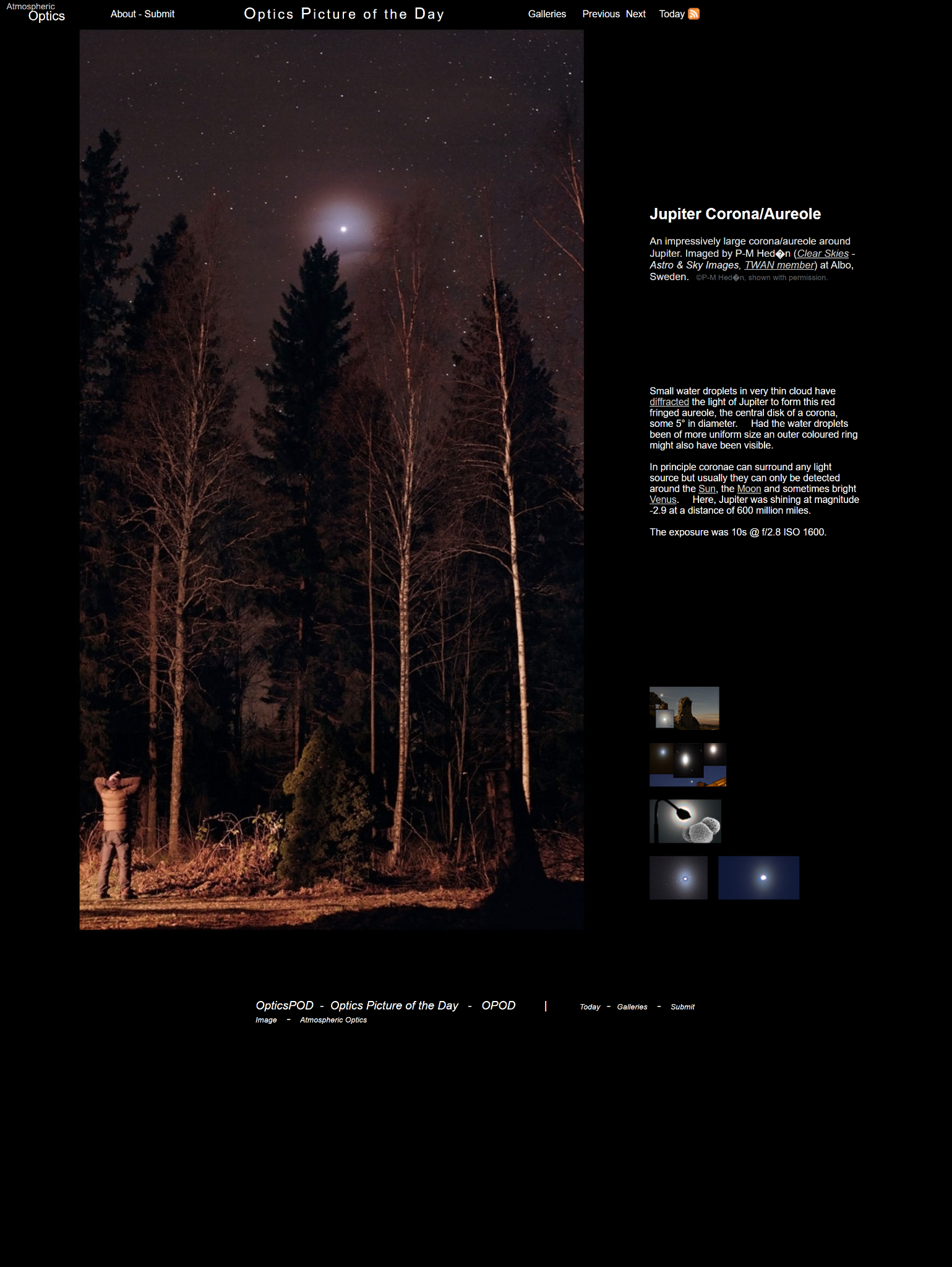OPOD - Jupiter Corona/Aureole
OPOD - Jupiter Corona/Aureole: A Stunning Atmospheric Phenomenon
Have you ever gazed up at the night sky and marveled at the beauty of the celestial bodies? Jupiter, the largest planet in our solar system, never fails to captivate us with its radiant presence. But have you ever seen a corona or aureole surrounding Jupiter? It's a truly breathtaking sight that can only be witnessed under certain atmospheric conditions. In this article, we will explore the fascinating phenomenon of the Jupiter Corona/Aureole and delve into the intricate details that make it so remarkable.
What is a Corona/Aureole?
A corona is a ring of light that surrounds a celestial body, caused by the diffraction and scattering of light by tiny particles in the atmosphere. The term "aureole" is often used to describe the central disk of a corona. Coronae can form around any light source, but they are most commonly observed around the Sun, Moon, and occasionally bright planets like Venus and Jupiter.
The Jupiter Corona/Aureole Unveiled
In a stunning image captured by P-M Hedén, an avid astrophotographer, we are treated to a magnificent view of the Jupiter Corona/Aureole. Located in Albo, Sweden, Hedén's photograph showcases an impressively large corona surrounding Jupiter. The corona appears as a red-fringed aureole, with a central disk measuring approximately 5° in diameter.
The Role of Water Droplets
The formation of the Jupiter Corona/Aureole is intricately tied to the presence of small water droplets in thin clouds. These minuscule droplets diffract the light emitted by Jupiter, causing it to scatter and create the stunning visual effect we observe. If the water droplets were more uniform in size, an outer colored ring may have been visible as well.
Exploring Jupiter's Magnificence
Jupiter, shining at a magnitude of -2.9 and located a staggering 600 million miles away, serves as the light source for the formation of the corona. Its immense size and radiant energy make it an ideal candidate for the creation of this atmospheric phenomenon. By capturing the beauty of the Jupiter Corona/Aureole, we gain a deeper appreciation for the wonders of our solar system.
The Technical Details
To capture this awe-inspiring image, P-M Hedén employed a camera with an exposure time of 10 seconds, an aperture setting of f/2.8, and an ISO sensitivity of 1600. These settings allowed for optimal light capture and ensured that the intricate details of the corona were beautifully preserved in the photograph.
The Splendor of Atmospheric Optics
The Jupiter Corona/Aureole is just one example of the many mesmerizing atmospheric optical phenomena that grace our skies. From rainbows and halos to sundogs and iridescent clouds, these captivating displays remind us of the complexity and beauty of the natural world. By studying and appreciating these phenomena, we gain a deeper understanding of the intricate interplay between light, particles, and atmospheric conditions.
Conclusion
The Jupiter Corona/Aureole is a sight to behold, showcasing the beauty and intricacy of atmospheric optics. With its red-fringed aureole and central disk, this corona serves as a stunning testament to the power of diffraction and scattering. Through the lens of P-M Hedén's photograph, we are transported to the enchanting world of celestial wonders, reminding us of the vastness and magnificence of our universe. So next time you gaze up at the night sky, keep an eye out for the elusive Jupiter Corona/Aureole, and let it inspire you to marvel at the secrets hidden within our atmosphere.

Jupiter Corona/Aureole
An impressively large corona/aureole around Jupiter. Imaged by P-M Hed�n (Clear Skies - Astro & Sky Images, TWAN member) at Albo, Sweden. ©P-M Hed�n, shown with permission.
Small water droplets in very thin cloud have diffracted the light of Jupiter to form this red fringed aureole, the central disk of a corona, some 5° in diameter. Had the water droplets been of more uniform size an outer coloured ring might also have been visible.
In principle coronae can surround any light source but usually they can only be detected around the Sun, the Moon and sometimes bright Venus. Here, Jupiter was shining at magnitude -2.9 at a distance of 600 million miles.
The exposure was 10s @ f/2.8 ISO 1600.
Note: this article has been automatically converted from the old site and may not appear as intended. You can find the original article here.
Reference Atmospheric Optics
If you use any of the definitions, information, or data presented on Atmospheric Optics, please copy the link or reference below to properly credit us as the reference source. Thank you!
-
<a href="https://atoptics.co.uk/blog/opod-jupiter-corona-aureole/">OPOD - Jupiter Corona/Aureole</a>
-
"OPOD - Jupiter Corona/Aureole". Atmospheric Optics. Accessed on November 26, 2024. https://atoptics.co.uk/blog/opod-jupiter-corona-aureole/.
-
"OPOD - Jupiter Corona/Aureole". Atmospheric Optics, https://atoptics.co.uk/blog/opod-jupiter-corona-aureole/. Accessed 26 November, 2024
-
OPOD - Jupiter Corona/Aureole. Atmospheric Optics. Retrieved from https://atoptics.co.uk/blog/opod-jupiter-corona-aureole/.